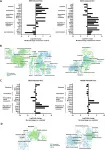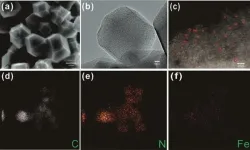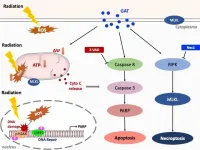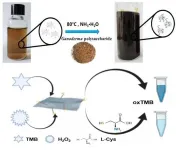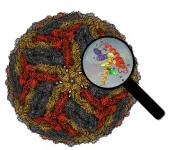(Press-News.org) Oncotarget published "Multi-modal effects of 1B3, a novel synthetic miR-193a-3p mimic, support strong potential for therapeutic intervention in oncology" which reported that the authors comprehensively investigated miRNA-193a-3p's mode of action in a panel of human cancer cell lines, with a variety of genetic backgrounds, using 1B3, a synthetic microRNA mimic.
Interestingly, the exact mechanism through which 1B3 reduced cell proliferation varied between cell lines.
1B3 efficiently reduced target gene expression, leading to reduced cell proliferation/survival, cell cycle arrest, induction of apoptosis, increased cell senescence, DNA damage, and inhibition of migration.
SiRNA silencing of 1B3 target mRNAs further highlighted the advantage of the pleiotropic mechanism of 1B3 action, as repression of individual targets did not achieve the same robust effect on cell proliferation in all cell lines.
Together, these data strongly support the development of 1B3 as a novel therapeutic agent for treatment of human cancer.
Dr. Michel Janicot from InteRNA Technologies BV said, "Despite decades of research and an unprecedented advancement of therapeutic options [1], cancer accounts for one in every six deaths worldwide, with ~18,000,000 new cases diagnosed in 2018 and expected to grow to ~30,000,000 by 2040"
"Despite decades of research and an unprecedented advancement of therapeutic options [1], cancer accounts for one in every six deaths worldwide, with ~18,000,000 new cases diagnosed in 2018 and expected to grow to ~30,000,000 by 2040"
Fittingly, miRNAs are commonly dysregulated in cancer, and can act as either tumor suppressor or oncogenic miRNA.
Antisense oligonucleotides against oncogenic miRNAs or synthetic copies of tumor suppressor miRNAs provide exciting novel approaches to cancer treatment.
As cancer is a multifactorial disease, this pleiotropic effect of miRNAs may be more effective at targeting different aspects of cancer cell biology.
Despite the significant literature on the role of miR-193a-3p in tumor development, and evidence that miR-193a-3p mimics reduce cancer growth, further studies with an efficient miR-193a-3p mimic delivery system are required to elucidate the possible use of miR-193a-3p mimics as a novel therapeutic intervention for cancer.
In addition, RNA-sequencing and subsequent pathway analysis in a panel of cell lines confirmed the multi-targeted nature of 1B3 by revealing hundreds of target genes with key roles in tumor cell survival, proliferation, and migration.
The Janicot Research Team concluded in their Oncotarget Research Output, "we have shown that the miR-193a-3p mimic, 1B3, consistently suppresses several pro-tumorigenic phenotypes in vitro. Some of these effects (e.g., viability) can be broadly applied to all cancer cell lines, while others (e.g., cell cycle arrest patterns) are unique to specific cell lines and genetic backgrounds. Using both individual and combined siRNA(s) we showed that no individual 1B3 target reproduced the miRNA effect which suggests that multiple, simultaneous, gene repression by 1B3 is more effective at reducing tumor cell growth than single gene targeting. These data add to the growing body of evidence that miR-193a-3p has an anti-cancer effect through several mechanisms, and that this overall anti-cancer effect is conserved regardless of tumor origin or genetic background. Finally, in two different in vivo models we showed a significant reduction of tumor growth. Together, this evidence supports the further clinical development of INT-1B3 as an anti-cancer therapeutic molecule."
INFORMATION:
DOI - https://doi.org/10.18632/oncotarget.27894
Full text - https://www.oncotarget.com/article/27894/text/
Correspondence to - Michel Janicot - janicot@interna-technologies.com
Keywords - miR-193a-3p, microRNA mimic, microRNA delivery in vivo, pleiotropic mechanism of microRNA
About Oncotarget
Oncotarget is a bi-weekly, peer-reviewed, open access biomedical journal covering research on all aspects of oncology.
To learn more about Oncotarget, please visit https://www.oncotarget.com or connect with:
SoundCloud - https://soundcloud.com/oncotarget
Facebook - https://www.facebook.com/Oncotarget/
Twitter - https://twitter.com/oncotarget
LinkedIn - https://www.linkedin.com/company/oncotarget
Pinterest - https://www.pinterest.com/oncotarget/
Reddit - https://www.reddit.com/user/Oncotarget/
Oncotarget is published by Impact Journals, LLC please visit https://www.ImpactJournals.com or connect with @ImpactJrnls
Media Contact
MEDIA@IMPACTJOURNALS.COM
18009220957x105
Copyright © 2021 Impact Journals, LLC
Impact Journals is a registered trademark of Impact Journals, LLC
A local research team, comprised of members of the Korea Institute of Machinery and Materials(KIMM) under the Ministry of Science and ICT and UNIST, developed a metamaterial absorber that significantly enhances the detection of harmful substances or biomolecules, and published their results in Small Methods.
The joint research team led by Principal Researcher Dr. Joo-Yun Jung of the Nano-Convergence Mechanical Systems Research Division at KIMM and Professor Jongwon Lee of UNIST developed a metamaterial that enhances infrared absorption spectroscopy through 100-fold amplification of detection signals. The proposed metamaterial is a special functional material with vertical nanogaps of a smaller size than infrared wavelength.
Infrared spectroscopy is a technique that identifies ...
Recently, the research team led by Prof. KONG Lingtao from Institute of Solid State Physics, Hefei Institutes of Physical Science (HFIPS) prepared a highly active single iron atom catalyst (Fe-ISAs@CN) which can activate H2O2 to generate free radicals, achieving rapid removal of sulfadiazine pollutants in aqueous. The relevant results were published in Journal of Colloid and Interface Science.
Sulfadiazine (SDZ), a kind of synthetic sulfadiazine antibiotic, is widely used in clinical and animal husbandry industries. However, due to its large-scale use and unqualified discharge of wastewater, more and more antibiotic residues ...
Recently, the research team led by Prof. KONG Lingtao from Institute of Solid State Physics, Hefei Institutes of Physical Science (HFIPS) prepared a highly active single iron atom catalyst (Fe-ISAs@CN) which can activate H2O2 to generate free radicals, achieving rapid removal of sulfadiazine pollutants in aqueous. The relevant results were published in Journal of Colloid and Interface Science.
Sulfadiazine (SDZ), a kind of synthetic sulfadiazine antibiotic, is widely used in clinical and animal husbandry industries. However, due to its large-scale use and unqualified discharge of wastewater, more and more antibiotic residues are detected in the ...
Graphene-based materials can be obtained using various reducing agents, many of which are dangerous and toxic chemicals, and the obtained graphene-based materials are prone to aggregation, limiting their practical applications.
Recently, a research group of Prof. HUANG Qing from the Institute of Intelligent Machines, Hefei Institutes of Physical Science (HFIPS), prepared graphene-based nanozymes through a simple and green preparation method, and verified that it can be used to detect L-cysteine in serum.
The study, published in Analytical and Bioanalytical Chemistry, was supported by the National Natural Science Foundation ...
According to the theory of planet formation, rocky bodies such as the Earth were formed by repeating collisions from dusty materials. In this process, a number of Mercury- or Mars-sized planetary embryos, were formed, and eventually these bodies merged together and formed terrestrial planets in our solar system. During the formation of the planetary embryos, the interior of these bodies was likely to be molten due to the heat by radiative-decay elements and a collisional energy of the planetary embryos. At this stage, iron and silicate separate, and form the metallic core and ...
It might seem like a given that mothers take extra risks to protect their children, but have you ever wondered why? A new study led by Kumi Kuroda at the RIKEN Center for Brain Science (CBS) in Japan shows that in mice, this and other nurturing behaviors are driven in part by neurons in a small part of the forebrain that contain a protein called the calcitonin receptor. The study was published in Cell Reports.
Many simple behaviors, such as eating and drinking, are driven by different parts of the brain's hypothalamus. The new study focused on identifying the part that drives a much more complicated behavior: caring for infants. As Kuroda explains, "we were able to narrow down the brain cells necessary ...
Most prescriptions for the drug buprenorphine, used to treat opioid use disorder, are written by a small number of the health care providers, according to a new RAND Corporation study.
Published in the June 1 edition of the Journal of the American Medical Association, the study found that half of all patient-months of buprenorphine treatment during 2016 and 2017 were prescribed by just 4.9% of the physicians and other providers who prescribed the drug during the period.
"These findings have important implications for efforts to increase buprenorphine access," said Dr. Bradley D. Stein, the study's lead author and a senior physician researcher at RAND, a nonprofit research organization. "Our study suggests that targeted efforts to encourage more current prescribers to become high-volume ...
In a recent study, Australian scientists used an original approach to resolve the 3D structure of flaviviruses with an unprecedented level of detail, identifying small molecules known as 'pocket factors' as new therapeutic targets.
Flaviviruses infect humans by mosquito or tick bite, with symptoms ranging from fever and myalgia to life-threatening neurological and congenital conditions. Flaviviruses such as dengue, yellow fever and Zika threaten almost a third of the world's population, and new flaviviruses emerge regularly from animal reservoirs with the potential to cause epidemics. ...
A research team led by scientists at Université de Montréal has developed a unique observational tool for assessing children up to 5 years of age who have had a concussion. The work is explained in a study published in the Journal of Head Trauma Rehabilitation.
Pediatric traumatic brain injury (TBI) is particularly prevalent in toddlers; they're more likely to be injured because they have a lower sense of danger and are still developing physically. But parents and clinicians have trouble detecting symptoms of trauma, given the toddler's limited verbal skills.
"A young child will not tell you that they have a headache or feel dizzy," said Dominique Dupont, an UdeM postdoctoral student in neuropsychology and first author of the study.
"But assessing post-concussion symptoms ...
PHILADELPHIA--An odor-based test that sniffs out vapors emanating from blood samples was able to distinguish between benign and pancreatic and ovarian cancer cells with up to 95 percent accuracy, according to a new study from researchers at the University of Pennsylvania and Penn's Perelman School of Medicine.
The findings suggest that the Penn-developed tool -- which uses artificial intelligence and machine learning to decipher the mixture of volatile organic compounds (VOCs) emitting off cells in blood plasma samples -- could serve as a non-invasive approach ...
